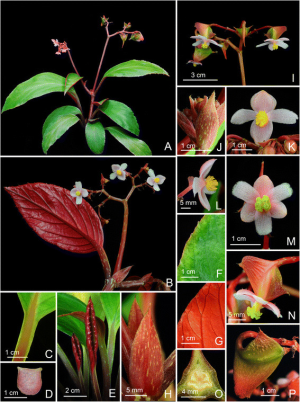Begonia caobangensis
Species Information
Classification and Distribution
Begonia caobangensis is a monoecious, perennial, rhizomatous herb found in Northern Vietnam. It is specifically located in Cao Bang Province, Tra Linh District, near Thang Hen Lake, at an elevation of approximately 1000 meters. It grows as solitary plants on soil slopes in forests with light to medium shade.
Characteristics
This begonia species features creeping rhizomes, deciduous reddish stipules, and red to crimson petioles. Its leaves are alternate, adaxially lime green and abaxially reddish to crimson. The mature leaves are flat, symmetric, narrowly elliptic to elliptic, with an acuminate apex and an attenuate base. The margin is repand to sparsely denticulate.
Flower Details
- Staminate flowers: They have four tepals, with outer tepals being broadly ovate and the inner tepals being pinkish and obovate. The androecium is actinomorphic, with numerous stamens. - Pistillate flowers: These flowers have six tepals, with outer tepals being obovate to elliptic and inner tepals being oblong to narrowly elliptic. The ovary is reddish and trigonous-ellipsoid, with unequal wings tipped with succulent bristles.
Etymology
The specific epithet "caobangensis" refers to the locality of the type collection, Cao Bang Province in Vietnam.
Similar Species
Begonia caobangensis resembles B. aequilateralis in having symmetric and elliptic leaves but differs in several features, including blade base, petiole characteristics, presence of succulent bristles at the tips of ovary wings, and the number of pistillate tepals.
Chromosome Cytology
Begonia caobangensis has a somatic chromosome number of 2n = 22.
Distribution and Ecology
This species is found in Northern Vietnam, primarily around Thang Hen Lake, Tra Linh District, Cao Bang Province. It grows in evergreen broad-leaved forests with light shade, at an elevation of approximately 1000 meters.
Care
Photos
references
